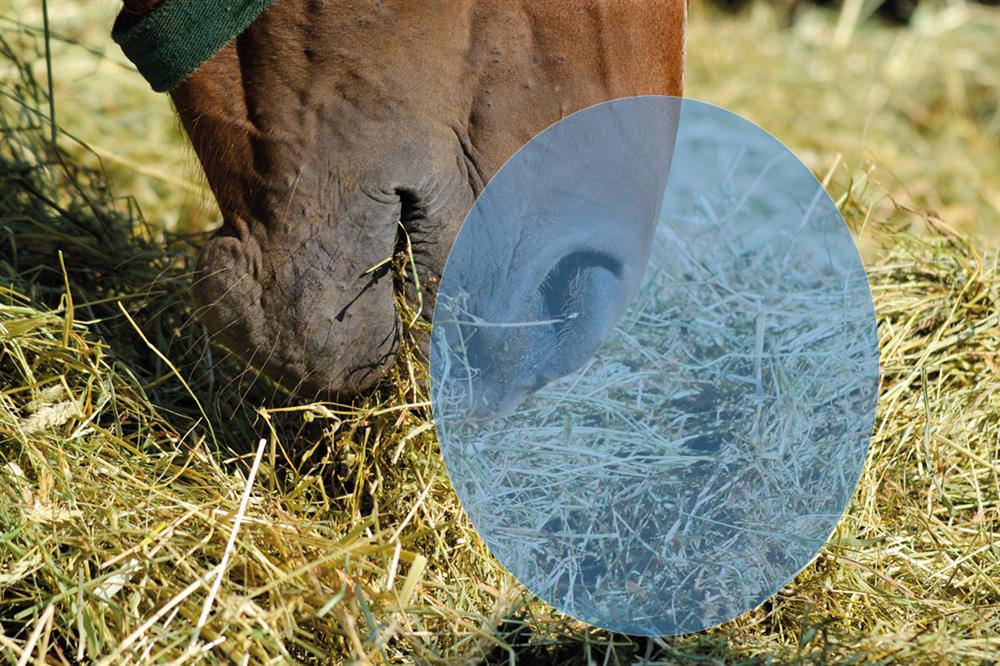Terminology change
Equine asthma is the term now used to describe non-infectious, lower airway inflammation, and has replaced use of the terms recurrent airway obstruction (RAO), chronic obstructive pulmonary disease (COPD), seasonal pasture-associated recurrent airway obstruction (SPARAO) and heaves. Equine asthma is inflammation of the horse’s trachea (windpipe), bronchi and lungs that is caused by physical irritation by particles, and not by an infection. Coughing, nasal discharge, and an increased effort to exhale are typical signs of equine asthma, commonly leading to reduced exercise tolerance and poor performance. Having to make increased respiratory effort is debilitating for animals affected and can be distressing for owners to see and manage.
The environment the horse lives in is key to reducing the risk of equine asthma developing in the first instance, and managing the condition on a daily basis. Airborne particles less than 5 microns in diameter (microscopic) reach deep into the horse’s lungs and cause this irritation, so minimising particles in the air the horse breathes is vital for maintaining respiratory health. Dust particles from bedding, especially straw bedding, forage, feed and the horse itself, plus moulds, microbial toxins and endotoxins produced by some bacteria, can all be present in the air and are associated with inflammation of the horse’s lower airway. Once inhaled the particles irritate the airway lining, inducing an immune response that leads to increased production of mucus in the bronchi and bronchioles (small airways in the lungs) which is more resistant to being expelled, thickening of the lining of the bronchioles, constriction of the bronchioles, and the requirement for greater physical effort to breathe. Once a sensitivity to these particles has developed, horses seem to have continued reactions to particles, meaning stabling can be particularly challenging to maintaining respiratory health. Even for horses without a history of respiratory sensitivity, the stable environment can pose a risk of developing such issues.
Reducing airborne particles
When stabling is a necessity due to poor weather or injury, you should take action to safeguard your horse’s respiratory health by reducing the airborne particles in the horse’s breathing zone (figure 1). The breathing zone is the area directly around the horse’s nostrils, as equids are obligate nasal breathers and so cannot breathe through their mouth. A reduction in airborne particles within the horse’s general environment is ideal, but particular attention should be paid to the level of particles in the breathing zone. With this in mind, the aim is to achieve a low-dust environment, with the following management practices recommended:
- Maximise time out of the stable where possible. Where this is not possible (due to health, injury or practical limitations) ensure the stable is well ventilated to replace stale air with fresh air, and promote removal of airborne particles (for more details on ventilation, tap here).
- Avoid bedding on straw as this is strongly associated with respiratory issues in equids. If baled when damp straw can contain Aspergillus moulds which can be particularly triggering for respiratory issues. Alternative options include dust-extracted shavings, paper or pellets. Regardless of bedding type used, it should be kept clean with low levels of ammonia which can also contribute to respiratory issues. When cleaning stables horses should also be removed as the level of airborne particles will increase considerably when bedding is being moved around the stable.
- Feed forage of good hygienic quality. Hay is particularly triggering for horses with respiratory issues, and hay that is baled with a high moisture content can spoil and contain moulds and endotoxins produced by bacteria. To reduce the potential of inhaling harmful particles hay can be steamed. Steaming should be at a minimum of 90oC for 50 minutes. If steaming of hay is not practical then feeding haylage of good hygienic quality, or bagged chaffs which are lower in dust and particles, is recommended.
 Figure 1. Horse’s are obligate nasal breathers, so the breathing zone for particles
Figure 1. Horse’s are obligate nasal breathers, so the breathing zone for particles
is focused around the nostrils and not the mouth.
- The method of feeding is also important and can considerably influence the level of particles in the horse’s breathing zone. When eating from a haynet, horses tend to push their nose into the haynet and then drag out hay, causing particles to be disturbed and inhaled. A better alternative is to feed forage from the floor or from a specifically designed forage feeder that allows the horse to eat with a lowered head position. This means the horse’s nose is above the level of the forage and the number of particles in the breathing zone is considerably reduced. Eating with a lowered head position also promotes natural drainage of the airways, promoting removal of the mucus which traps particles and reduces their passage to the lungs.
- Always dampen bucket feeds. When eating out of a bucket the air in the breathing zone is contained by the sides of the bucket. Dampening feeds reduces the likelihood of horses inhaling feed related particles.
- Avoid grooming the horse in the stable as this will increase the particles in the air. Where possible do this in an open, well ventilated area, where the air passing by the horse’s nose is constantly moving and being refreshed.
If you would like any advice, please contact our Equine Nutrition Team who would be happy to help you. You can email [email protected] or call our freephone advice line on 0800 585525.

